Hello, hello, hello. This is Lisa Betts-LaCroix. Today before I jump into our topic, I want to give a big shout out to Mary Roger's who is the host of the Experience 50 podcast. I have done a bunch of interviews on other people's shows recently but this week
Mary Roger's Episode #124, which I was so thrilled and honored to be a guest on, came out. So, I really want to point you over to Mary Roger's
Experience 50 Podcast. You can listen to any of her shows and get so much out of it. Here's the thing she says, “you are a grown up at 50 and there are no more excuses for a life that didn't turn out the way you thought it would. In these episodes, you're going to learn the stuff you should know by now. You will also hear stories of mid-lifers making pivots, reinventing themselves because they just don't care what other people think anymore. Woohoo! So, I just want to encourage you, if that fits you and your life right now head on over to the Experience 50 Podcast. Mary is just a stellar interviewer. Super fun. Super gracious. Very generous and smart and funny.
So, today's episode is all about fasting and before we jump in I want to give a big nod to
Phil Libin who is currently the CEO of the AI startup
All Turtles as well as the former CEO of
Evernote, the platform I'm using to outline my plans for this show. Besides this great tool, Phil's contributed to my life in a few ways. Back when I co-hosted the Silicon Valley Chapter of
Quantified Self he was the most generous host of my favorite meet-up of that era…which incidentally was also the event where my Ep #7 guest
Tiago Forte and I first met. If you haven't already, go back and listen to
Ep. #7 with Tiago Forte is you haven't yet. It's a great show on productivity and creativity and the merging of the two. Phil also introduced me to the best Mexican Chicken soup on the San Francisco Peninsula at
La Fiesta restaurant in Mountainview (a fact he very likely doesn't even remember but which is cool because
I'm kind of a fan of soup in general and chicken soup in particular). And most recently certainly unbeknownst to Phil, he got me fired up about the topic of today's show, Fasting!
I've been around and exposed to many approaches to bio-hacking over the years and I have experimented with various diets and lifestyle options believed to increase human healthspan and longevity…
lots of people in my circles are committed to curing aging and living longer, healthier lives. So fasting has been on my radar for a long time. But for some reason reading an article Phil either wrote or was the subject of, about a year or so ago got me a lot more excited about exploring the topic for myself. And the reason I'm not completely sure if the article was about Phil or by him, is because I there are a lot of articles about Phil and fasting. Here are a few:
So today I want to touch on some of the most commonly used protocols or types of fasting approaches, the benefits fasting is believed to offer, how I'm currently approaching fasting and my experience with it. And if you stay to the end of the show for the first every ongoing Super Power U experiment and a description of how it's going to work. And throughout there will be a lot of resources for anyone who's interested in giving fasting a try.
Types of Fasting
Generally, when I refer to fasting, I'm talking about water fasting or “clean fasting” which for me personally, does not include coffee, flavored water, diet soda or even tea. Some people consider a fast to be anything that doesn't involve calories but I find that my taste sensors turn on when I drink anything other than water and I find it makes fasting harder for me. So the only thing I drink other than water is sparkling water or carbonated water. This is just my little peculiarity though and I'm sure that many people drink flavored sparkling water with absolutely no negative impact on their fasting.
I'll say this now and I'll say it again. This process is an individual process and it probably should be said that I'm speaking about my own personal experiences with fasting. I'm obviously not a doctor and nothing in the process should be considered medical advice.
In addition to my own experience, I wanted to be able to share some other protocols and approaches so when I started this episode I asked friends about their fasting protocols and so I know that some people drink coffee with butter or MCT oil) or have some other form of pure fat to provide energy and to keep the hunger at bay during their fast. Now the thinking on this is that because there's no excess protein or carbs to convert to glucose the body is acting as if it's fasting and depreciates the glycogen stores stimulating ketosis.
So here's a brief aside on ketosis. Put most simply, ketosis is a metabolic process the body enters when it's using fat as a primary source of energy rather than carbohydrates. If you want more detail on it please see “
Ketosis Explained“.
So I mentioned this before and I'll say it again, everyone approaches fasting differently and one of the most important things is that you take an attitude of experimentation and adapt your fasting process as suits your needs, your personality, your desires, your body and your experience. And I generally think that the type of fasting one chooses and the interpretation of the word fasting is determined largely by that person's goals or reason for fasting.
So for example, people who are fasting for weight loss may be trying to reduce or avoid calories. So, they might consider having a drink with a tiny amount of calories or even drinking clear broth to be an unbroken fast because for the purpose of losing weight one could argue that based on the calories in / calories out model they'd be reducing their calorie intake. Whereas someone who is fasting to give their digestive system a break may consider drinking juice or other clear liquids, also known as a juice fast to be just fine and for their purposes that may be true. Though for the purpose of losing weight it may not be because juice has a lot of calories in the form of sugar.
Next is the question of the various approaches which determine WHEN we eat. Very likely you have heard of intermittent fasting which refers to cycling between fasting and eating periods. And there are various versions or protocols generally referred to by the length of the fasting to eating windows.
Wikipedia suggests that protocols can be grouped into two primary categories: Whole day fasting vs time-restricted feeding. Whole day fasting can vary from occasional not eating for a day to weekly one-day fasts to alternate day fasting which means fasting for a whole day every second day. The most extreme form would be long multi-day fasts. This is not so much what I'm focusing on in this episode in spite of the fact that I suspect there are some really powerful long-term health benefits for me, it's pretty far outside of the realm of possibility right now. It's just not where I'm at on the journey. (Note: There are a lot of other types of fasting practices I wasn't able to mention in the show since time prohibited a comprehensive review of all fasts. These articles on
livestrong and
global healing center describe other types of fasts including partial fasts, diagnostic fasts, and religious fasts.)
So one of the most common approaches and possibly the easiest to start with is the 16/8 fast which means that you limit your eating to an 8-hour window after fasting for 16 hours. So, for example, that if you had your first food or drink at 10:30 you would finish your last meal by 6:30 pm. That means you're eating from 10:30 in the morning until 6:30 at night and fasting from 6:30 at night until 10:30 in the morning. This a pretty gentle way of beginning since really it just means having a later than usual breakfast and possibly an earlier than usual dinner. And yet, it is a big improvement from the standard American style of eating where we might be drinking coffee, eating food and snacking from the moment we get up until the moment we go to bed. So, in some cases, for some people starting with a 16/8 fast is a reasonable and gentle way to begin.
The variations of intermittent fasting time can range from that 16/8 protocol to 18/6 where you're fasting for 18 hours and eating in a 6-hour window to 20/4 which means fasting for 20 hours and eating in a 4-hour window and so on. The first number refers to the hours fasting and the second refers to the eating window time.
If you read the articles above on Phil Libin's approach you'll see that he's pretty radical. Phil actually started with a 3 day fast and said that on the first day he was hungry, the second day was harder and on the third day he felt amazing. His experience is consistent with the information I've heard through
Jason Fung, a doctor from Toronto who I'll say more about later. Apparently,
Ted Naiman has
a great graph that shows the greatest benefit from fasting occurs between 18 and 24 hours of fasting. While there are added benefits to longer-term fasting because day 2 tends to be the most difficult the best benefit for the lowest pain is thought by many to be that sweet spot between 18 and 24 hours. Naiman's
Burn Fat, Not Sugar site is another great resource.
Phil now foregoes food for between two to eight days in a row, drinking only water, coffee, and tea and from what I've read it's just become a lifestyle for Phil.
So what I'm doing isn't nearly as extreme as Phil's protocol. Right now I generally fast from Sunday night until Tuesday morning aiming for a 40 hour fast. So, I'll usually try to finish dinner a little on the early side on Sunday night. And then I make Monday a pretty intensive work day. I see it as an opportunity for me to get in some real focus time and so I tend to avoid scheduling meetings, coffee dates or lunches. And I drink water ideally all day and certainly if I feel hungry. And I'm going to say a little more about water now because drinking water is really, really important and I learned that the hard way. Two weeks in a row I felt terrible on the Tuesday morning when I woke up. I felt horrible. I had a horrendous headache, I felt nauseated and what was apparently a blood sugar crash but felt like my blood pressure was dropping. And I realized that it was because I was dehydrated. So now I drink water all day and it is amazing how much of a difference it makes.
For me, the Monday after evening, the one long full day of fasting, have been, in the past, the most difficult time. But the thing I'm realizing is that it's mostly, for me, psychological. Eating is fun and it's a habit that's hard to break even when it hasn't actually been long enough for real hunger. For those reasons I usually go to bed a bit early on Monday nights because I kind of want the day to end a little early.
The first few times I fasted I can tell you, were really difficult. I dreaded it…in fact, before I started I was sure I wouldn't be able to do it. And then once I did it, I was amazed but I didn't want to do it again and in fact, I stopped for months because it just seemed so hard. Now I've found that changing some of my thinking patterns around it, I can spend the day pretty much as normal even though I do like having a very focused work time with no need to take breaks to cook and clean. But I've found that once I'm in the mode, and in the swing of things, I can even cook and sit with my kids while they eat.
OK, so, Tuesday is my break fast day. I find myself really looking forward to my coffee with steamed half and half. If I'm feeling strong I wait for a while which means that depending on the time I break my fast I'll have, without that much effort, achieved between a 36-hour and a 40-hour fast which I see as a lovely sweet spot between the cost and the benefits.
So, I'm early in my fasting journey but the fasting I've done so far makes it pretty clear to me that for me at least after getting over the psychological hump, which again really is the hardest part of me, that physically my blood sugar stabilizes by fasting. For me, and I keep saying that because it should be clear that I'm not a doctor and I'm not giving medical advice, rather I am sharing my own experience…for me those “I'm starving, I've got to eat, I feel shaky”, are actually more related to the crash after too much regular eating or even overindulged or sugar or a lot of carbs. When I'm actually in a fasting mode I feel much, much more steady.
I said this already but I'm going to say it again. Water is so critically important…so important to fasting. If there's one way you're going to feel bad it's probably from dehydration.
Will Eden who is a local Silicon Valley VC friend, has written the fantastic
Quick Starter Guide to Fasting. Give it a read; there's lots of great information in it. In his post, Will affirms the point I'm making about the importance of water. He says,
“The number one reason I feel bad during a fast is dehydration. Actually, almost every single time it's dehydration. We are used to getting a large amount of our water from food, so you will need to be drinking more fluids to reach the same level of hydration as before.”
Super important! And consistent with my experience. Do not forget to drink water through the day; I have a glass of water beside me all day long and I drink it continuously. It fills me up, hydrates me and gives me something to ingest.
As for benefits, there are believed to be many. There is a lot information online and in the blogosphere and the podisphere about the benefits which range from weight loss and fat burning to improved insulin sensitivity, decreased blood sugar, improved triglyceride markers, and reduced inflammation, to cell regeneration and protection from age-related decrease in brain function. And that is just a start.
I'm going to include some articles and resources in the show notes in addition to the ones I have time to mention here but for the purpose of time I'm going to touch briefly on the benefits I'm after…the reasons I personally fast. And those have to do with autophagy, which is a kind of cleaning of the cellular gunk, let's say, that is believed to be very positive for long-term health and also insulin regulation. Essentially, being in a constantly “fed” state is not normal or particularly good for our bodies. It's believed by some to contribute to the possibility of Type 2 diabetes. So the corollary is that fasting can moderate and stabilize the blood sugar response in the body and insulin levels, which can reverse or delay the onset of Type 2 diabetes –generally an extremely healthy choice. Fasting initiates the body's ability to feed on its own fat through an autophagic response, cellular regeneration occurs. So, fasting kicks in and starts to reduce inflammation, and stabilize blood sugar, And all of these pieces together are thought to reduce the risk of age-related diseases and in general contribute to long-term health. For more details and information, here's an article by
Dr Eric Berg on Autophagy.
Yet again it seems like 18-24 hours is the sweet spot to aim for when fasting. Many people fast for the purpose or benefit of weight loss. The thing is, you cannot burn fat if you are constantly eating. Consistent eating, even if we're also consistently burning it off, does not allow us to access our fat stores but rather uses our glycogen stores for energy.
Which brings us back to
Jason Fung, who is a Canadian nephrologist from Toronto, Canada. He's a world-leading expert on Intermittent Fasting and especially focuses on treating people with Type-2 Diabetes and Obesity at his
Intensive Dietary Management Center. He uses the concept of a
two-compartment model which is an analogy to a refrigerator and deep freezer to help people understand how fat is stored in the body. He likens glycogen stores from food in the body to that which is in a refrigerator –it's easy to get at but has limited storage. Because the refrigerator space is limited you might need a freezer where you can store more stuff, which is the metaphor for body fat. Like the freezer, which, in real life might be in your basement, it's a lot harder to get at the fat to burn it off. So most of the energy we use works off the glycogen stores in the metaphorical fridge. The food goes in and then when you use the calories it goes out, all operating from the fridge. Meanwhile, fat is accumulating in the freezer. Jason Fung says that insulin is key!
“When insulin stays high, you can't get at the body fat, so you can't burn it. And if you reduce your calories but you eat all day long you're stimulating your insulin which then remains high and you're never accessing the stored fat in the freezer. On the other hand, when insulin goes down it's a signal to access the fat in the freezer.”
So the point of fasting as Dr Fung sees it is to give yourself enough time for those insulin levels to drop so you can access that body fat so you can see how fasting contributes to insulin regulation which helps reverse or avoid Type 2 Diabetes reversal but also is a great way to access stored fat in your body and to start to burn it off.
So those are the two primary reasons I fast. Mostly, for the long-term health benefits. But because long-term health is hard to see and therefore hard to be motivated by, I use fat loss (or getting to an ideal weight) through fasting as my proxy –the feedback loop that fasting is actually contributing to my life in a positive way in a more short-term way.
I've been fasting for a while and I feel that I'm not quite as in the swing of things as I'd like. I'm only fasting one day a week and then the rest of the days are really hit-and-miss. I'll try to hit 17 hours but lots of times I won't. I'm not paying that much attention to what I'm eating so I'm going to use the show as a place to do an experiment. I hear a lot from the podcasts I listen to on IF and things I'm reading that it really is an adjustment and that is my lived experience. I feel that I'm early on the journey and that I don't really know where I'm going to end up but I feel pretty committed and convinced that a lifestyle that includes intermittent fasting is going to be a Super Power for me healthwise. So it's something I'm really committed to developing and deepening in terms of my practice. And a lot of that has to do with habit adjustment. Because the show is all about celebrating and building on Super Powers and because it's a venue for my own work on myself–and I take you along on my learning and growing journey, I'll record and update on a segment I'll call Lisa's Fasting Protocol Update. This is the week of May 8th so I'm going to do ongoing show segments in June, July and August, once a month. So I have no idea what the reports will be because it is an experiment, but you can look forward to the first check-in on Ep #27 the week of June 7, the second on Ep #31 the week of July 5, and third on Ep #35 the week of August 2nd. So come on back then to see how it goes and if you're listening to the back catalog you can jump ahead and see how it went. And that my lovelies, is the perfect time to remind you to please subscribe to the show (on
Apple Podcasts,
Stitcher,
Google Play or any podcast player) so you don't miss any episodes. You'll also help us reach more people since subscriptions really do help our ranking.
So I'm going to jump to a couple of suggestions. Again, there's drinking water! It's really important for helping to feel full and to make sure you don't get dehydrated. And another thing that's suggestion by a lot of people is to, during your eating window, eat more healthy fats and fewer carbs. So my friend
Cindy (Dinh) Riach suggests eating a whole avocado with a meal or even a handful of olives because healthy fats are a better source of energy than rice or beans or carbs. She also suggests being gentle with yourself, and not beating yourself up, letting yourself enjoy your food.
I am also going to think back on
Rachel Hart's Think-Feel-Act cycle from
last week's episode to explore the thoughts that come up for you and the resulting feelings around eating and fasting and what eating means and what not eating means. Because historically if you, like most of us, associate that feeling of hunger, or the gnawing discomfort of your stomach rumbling to not eating it's possible to start to build new associations. We can remember for example that the presence of hunger is a healthy state. We can start to create new associations so instead of thinking of fasting as a day of deprivation it will make the process a bit easier. You can also read or listen to podcasts on the benefits you're getting from fasting. Here are some suggestions:
And then one of the things I've been doing recently is to replace the dinner out I might have had with friends with a massage or a soak in the gym hot tub. Also, getting a friend or partner to fast with you is helpful. And did I mention? Drink lots of water! Early on in the process, it's helpful to find distractions and as long as you're choosing…maybe pick something that has other benefits. Finally, remember that it's a process and especially in the early stages it can be challenging…but keep on coming back. And that's why I'm creating this exercise for myself. Because I'm reminded and I'm reminding myself that it's an adjustment. It's a lifestyle to get used to and building habits takes time. So, I'm looking forward to the next month and to seeing how I can slowly adjust and adapt to a new process. I'm going to be focusing on continuing with my once-a-week 40-hours fast, from Sunday to Tuesday, aiming the rest of days for that 18-24 hour sweet spot which means I'm going to lean toward the OMAD approach which is the One-Meal-A-Day over the course of over 4 hours. Or you can eat it all at once. But I'm going to be aiming to stay within a 4-6 hour eating window. If you want more information on OMAD a good resource is the
Girl Gone OMAD Podcast or Gin Stephen's book
“Delay, Don't Deny” (affiliate link) in which she describes opening her eating window with a snack or appetizer followed an hour or two later with a meal, then a treat or dessert to close her eating window. Other people, like my friend Lisa, who's an incredible jewelry artist over at Byzantia
Jewelry doesn't eat breakfast or lunch and then eats a normal dinner of whatever she wants. Interestingly, and perhaps importantly, she doesn't think of it as fasting.
So my intent over the next month is to lean in that direction with One-Meal-A-Day spread over the course of between 4 and 6 hours per day. In addition to the monthly check-ins you'll find on upcoming shows, I'm going to be tracking this process on a more regular basis on the Facebook page. So if you search on
Super Power U and “like” the page and then join the
Super Power U Group it would be great to have you there. If you're working on IF I'd love to hear your process and be with you in the next months.
Thank yous!
Before I wrap up today I want to send a big thank you to a number of my friends who jumped in to offer resources, personal experience, and encouragement for this episode. I already mentioned Will Eden and his
Quickstart Guide to Fasting. The Guide is posted on his
Becoming Eden Blog which he writes with his wife
Divia Eden, a private tutor who'll be a guest on an upcoming parenting episode I'm working on.
I'm also grateful to
Cindy (Dinh( Riach actor and coach at Relational Ops who shared her process and tips,
Sascha Karr Berlin director of Founder Institute who aims for a 19-21 hour fast using the
Zero App and who recommends
Dr. Rhonda Patrick's interview
with Satchin Panda on Time-Restricted Feeding, which is a great watch. I'm grateful to
RJ Briggs for his inspiration for offering inspiration with his success getting to 14% body fat with a 16/8 approach by skipping breakfast, eating moderately and avoiding sugar completely.
Theodore Agranat, autodidact and entrepreneur who used to do 10-day water fasts a few times a year now fasts daily for 20 hours – with just a 4-hour eating window and feels great doing it. Thanks to Miquela Alejandre, florist and founder of
The Bloom Equation, who shared with me that she did a juice fast for 10 days and by the end felt elated all the time. Thank you to
Mark Hamade conscious capitalist, investor and public speaker. His incredible story of persistence, coming through cancer twice and losing over 200 lbs of body fat has been supported by his Intermittent Fasting protocol and more. I hope to feature his story soon. Finally, thanks to Diana, Dan, Keith, Kimberly, Marcie, Katherine, Willow and others who contributed ideas or encouragement.
I'm very sensitive to the fact that I'm publishing to the fact that I'm publishing back-to-back episodes, one on taking a break from alcohol and the next on Intermittent Fasting and I want to put out an extra word for the possibility of seeing both of these processes as empowering and healthy. And an extra word and reminder for us all to be gentle and kind starting with ourselves. As always, thank you for being here and in addition to my thanks I want to put a word in for incredible gentleness and compassion. If you can take a slow deep breath and think of the people you know and those you don't know who are facing challenges. I would so appreciate it if together we could send warm thoughts out to those who are struggling facing challenges, physically, mentally, emotionally. Thank you for doing that…because we are all in this world together. Thanks for being with me here again this week. I look forward to seeing you in the
Super Power U Group so we can keep talking about this process together. And see you back here next week for my interview with Maya Lockwood.
Addendum to the podcast:
It is important to note that most of the scientific research, while compelling and pretty suggestive of benefits, is not considered by many to be scientifically sound because it's primarily been performed on mice since it's difficult to get human's to adhere to restricted eating without adding in confounding variables which may reflect correlation rather than causation. studying people who are willing to agree to and adhere to not eating might select for people who have other traits and so not many good quality human studies have been done. A lot of the referenced scientific studies use mouse models as a proxy for human response and are therefore potentially inaccurate.
More Resources:
Resources:
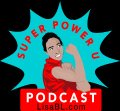


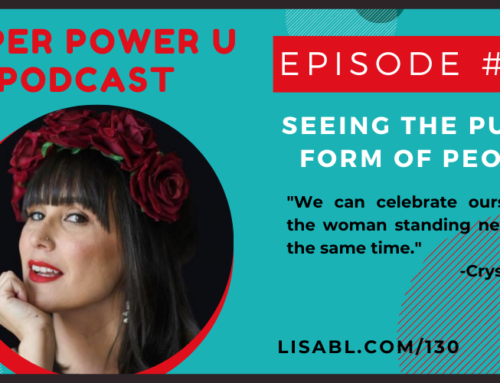

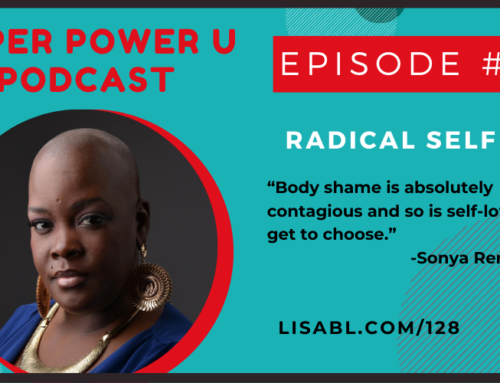
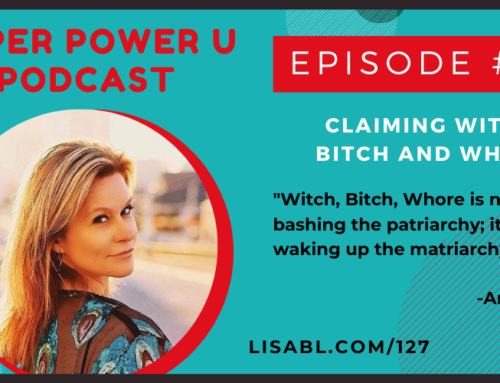
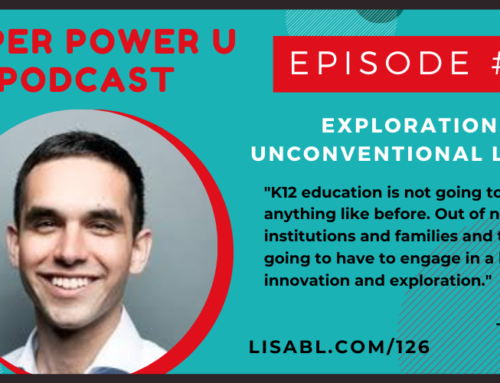
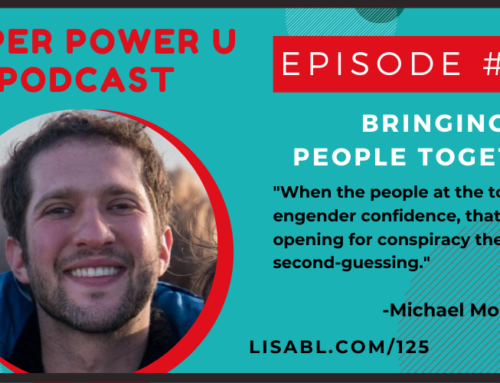
[…] forms. I have on my show a whole episode on an introduction to intermittent fasting called Intermittent Fasting – A Primer. One of the most common ways that people start out with intermittent fasting is by doing a process […]